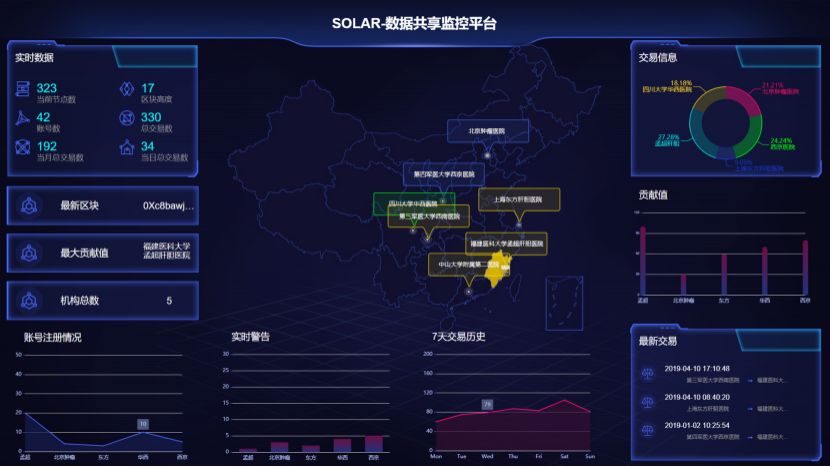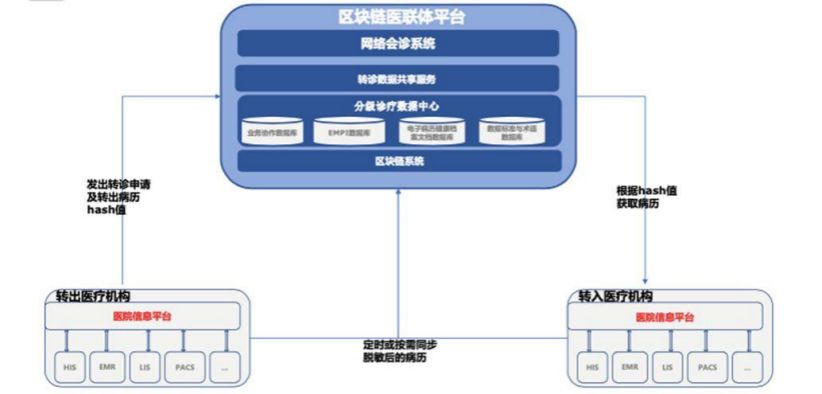How does the most secret medical data flow through the blockchain?

Text: Pizza
Source: A blockchain
Editor's Note: This article has been deleted without altering the author's original intention.
- Breaking through the impossible triangle of the blockchain (5): Lightning Network, off-chain technology, and their limitations
- The halving market disappeared and the risk aversion property became empty, and there was only one Bitcoin price support
- How to understand ETH2.0: start with understanding terminology
"Chinese doctors are a special group. No doctor in any other country can withstand the pressure of Chinese doctors."
Zhang Jianzhen, the director of the documentary "Doctor of China", once felt that way.
She found that nearly one in five Chinese doctors worked more than 80 hours a week. Some doctors in the top three hospitals perform three operations a day and work 17 hours.
Under such circumstances, doctors have become one of the occupations with the highest rates of sudden death, and doctor-patient conflicts have erupted from time to time.
In fact, this problem can be effectively solved through hierarchical diagnosis and treatment. However, subject to various conditions, the implementation of graded diagnosis and treatment encountered various challenges.
Blockchain technology will become a big weapon to solve this problem. With it, patients can no longer flock to large hospitals because of minor illnesses, and doctor-patient conflicts may be greatly reduced as a result.
In terms of ensuring the safe and efficient circulation of medical data, blockchain technology can also solve many problems.
In addition, in the process of building a blockchain platform, the medical industry will also be forced to continuously improve its digital level.
Blockchain technology is gradually taking root in the medical industry. Opening the data island between the hospital and the hospital to allow the patient's medical information to flow safely. This day is no longer far away.
01 Medical Puzzle
A new crown of pneumonia outbreak has made doctors and nurses a national focus.
It is undoubtedly touching that medical staff across the country are supporting Hubei and rushing forward to the front line of the epidemic. However, in the face of the epidemic, the medical industry has also exposed a series of problems, such as being questioned about concealing the epidemic and making it difficult for patients to be referred.
Can these problems be solved with blockchain technology? The answer is yes.
Medical data and information circulation is the first field where blockchain has landed.
Medical data has always been a highly sensitive type of data, and they are often easily leaked.
"The reason why medical data is being watched is simple. The data is of great value. Once it is obtained, it can be used for various commercial purposes." Li Yan, head of relevant products at the Fuzhou Data Technology Research Institute, told a blockchain.
She takes the data of newborns in a region as an example: Suppose that the data of newborns in a certain region are obtained by the local diaper company, this company can precisely adjust the production capacity and obtain more profits.
In addition, some Putian hospitals are also keen to acquire personal medical information of patients on the black market, and then trick patients into going to the hospital for treatment.
Due to the huge commercial value of medical data, data breaches often occur in this industry.
The report released by the foreign security agency Risk Based Security shows that since 2015, domestic and foreign medical data leakage incidents have occurred continuously. In the first half of 2019, there were 224 data leakage incidents in the global medical industry.
"In the medical industry, the internal threat of data is greater than the external threat. The survey shows that in the data leakage accidents of medical institutions, internal surveillance self-theft accounted for 60%. This is rare in other industries." Li Yan said.

In addition to the data breach problem, the medical industry is also facing the problem of data silos.
"China has two sets of health and medical management systems-the medical management system and the medical insurance management system, but they are not interoperable." Li Yan told a blockchain. "Among them, many standards in the medical management system are missing and electronic medical records are missing. The templates are incompatible with each other, and there are huge differences between provinces; the medical insurance management system has relatively uniform standards, but cross-province remains a problem. "
In many medical institutions, electronic medical records and checklists are not yet universal, and doctors still need to write medical records, which is not only inefficient, but also brings obstacles to patient consultations and referrals.
In addition, medical data faces the problem of artificial fraud.
A 2018 data show that 30% -50% of the information in the structured medical data is untrue. In some medical institutions, medical staff rely on "copy and paste" when recording medical records. At the same time, there are endless cases of patients and even hospital fraud. In the face of huge benefits, tampering with data is often unavoidable.
Facing these problems, the medical industry urgently needs the empowerment of blockchain technology.
02 Medical Data Management
Data is easy to leak, tamper with, and difficult to share, making medical data management a challenge. And because of the advantages of decentralization, traceability, and non-tampering, the blockchain is expected to become a great tool in medical data management.
In 2016, Tsinghua University initially built a SOLAR platform based on new technologies such as blockchain and edge computing. Since then, Tsinghua University and the Fuzhou Municipal Government have jointly established the Fuzhou Data Technology Research Institute, and the SOLAR team has been formally established.
This system has established a data sharing architecture that takes into account both data right confirmation and privacy protection, and has realized credible, manageable, and traceable data storage, circulation, and privacy protection.
"At present, there are three major scenarios for our application of medical data, namely scientific research data sharing, alliance regulators and personal health data safe deposit boxes." Li Yan, product leader of the SOLAR team, told a blockchain
Among them, scientific research data sharing focuses on the B-end, mainly for medical institutions such as hospitals; alliance regulators focus on the G-end, mainly serving the government and other regulatory agencies; personal health data safe deposit box services focus on the C-side, and provide services for individual users.

SOLAR Scientific Data Sharing Platform Interface
In the B-side scenario, hospital A can submit a data application request to hospital B, and the latter responds to the demand, and the platform will upload the data shared by the latter to the chain. Follow-up situations, such as which data of Hospital B was used by Hospital A, the number of times of use, and whether it was transferred to a third-party hospital are all clear.
"The data is transferred on the scientific research data sharing platform, and the data is traceable. This guarantees the security of the data." Li Yan said.
In the case of the personal health data safe deposit box on the C side, the platform can serve patients with chronic diseases and more people, allowing them to better grasp their own physical conditions.
At present, the platform has launched a sugar control application, mainly serving pregnant women.
This is because women have higher basal metabolism during pregnancy. Therefore, some pregnant women will face the three high risks of high blood sugar, high blood pressure and high blood lipids, which will cause gestational diabetes. In the case of SOLAR's personal health data safe deposit box, pregnant women can record and monitor their blood glucose data in real time through wearable devices.
At the same time, this information can also be shared with the hospital through the blockchain platform, allowing the hospital to grasp the blood glucose status of pregnant women in a timely manner.
In fact, the secure circulation of medical information such as medical records and prescriptions is also the first field where blockchain has landed in the medical industry.
As early as April 2015, American Blockchain Enterprise Notary Communication announced that it cooperated with medical record service solution provider Healthnautica to use blockchain technology to protect medical information and prevent data tampering.
In March 2016, the established company Philips also announced the establishment of a blockchain laboratory to study the application of blockchain in the medical and health industry.
In China, in 2017, Tencent cooperated with Guangxi Liuzhou Workers' Hospital to realize the "out-of-hospital prescription transfer" service based on blockchain. Patients can prescribe in the hospital and buy medicines outside the hospital.
In this process, the blockchain can prevent the prescription information from being tampered with, so that the prescription is still valid outside the hospital.
03 graded diagnosis and treatment
The advent of blockchain technology has also brought new opportunities to the hierarchical diagnosis and treatment system.
In the medical industry, the call for tiered diagnosis and treatment has a long history-the so-called tiered diagnosis and treatment, that is, according to the priority of the disease and the ease of treatment, allow different patients to diagnose and treat in different levels of medical institutions, to avoid the large hospitals and waste medical resources.
Under the epidemic situation, graded diagnosis and treatment can also control the spread of the epidemic situation and prevent cross infection.
However, in reality, grading diagnosis and treatment face many obstacles.
"Medical data sharing is difficult, which is one of the reasons why hierarchical diagnosis and treatment are difficult to carry out." Wang Maolu, the founder of Beijing Consensus, told a blockchain. For patients, transferring from a community hospital to a higher-level hospital requires the transfer of a series of medical data such as medical records and checklists, and the process is very cumbersome.
Blockchain has established a data management and sharing mechanism between medical institutions at the level of technology platforms. On this basis, graded diagnosis and treatment are not difficult to achieve.
In August 2017, Alibaba Health announced a pilot project of "Medical Alliance + Blockchain" in cooperation with Changzhou. Hierarchical diagnosis and treatment is one of the research areas.
In this project, when residents undergo physical examinations in community health centers, if they are screened for cardiovascular and cerebrovascular diseases, community doctors can implement authorization and transfer of medical records to higher-level hospitals through blockchain.
How did this happen?
Specifically, during the patient referral process, the transferring hospital will fill out the referral application and send the hash value of the corresponding medical record to the blockchain node. After receiving the referral application, the node will automatically detect the existence of the medical record and push the referral application and patient information to the referral hospital.
After transferring to the hospital to confirm receipt, you can retrieve the medical record file on the blockchain through the hash value , and use this to guide the patient's diagnosis and treatment.
In this case, patients do not need to repeat the two basic examinations, they can enjoy the full range of medical services of doctors at all levels in the medical union to achieve "early detection and early diagnosis and treatment."
Specifically, the medical data itself is not on the chain, and the on-chain platform is only responsible for indexing, attaching, and identifying authentication requests for the data directory. After receiving the medical information requirements, the platform will check the institution's private key, and realize private key isolation and data encryption transmission.

Transfer flowchart
It is worth mentioning that the blockchain technology has not only played a role in the fields of medical information management, hierarchical diagnosis and treatment, but also improved the level of dataization in the medical industry.
"The medical industry is still an industry that relies more on manual work by doctors." A blockchain practitioner said, "Many hospitals generate a large amount of data every day, such as patient checklists, medical record information, etc., but many doctors are still accustomed to reading Paper checklist. The level of dataization in the entire industry is not high. "
With the establishment of various blockchain medical platforms, many medical institutions have finally started to realize the digitalization and standardization of medical data.

"All hospitals have their own data. We pushed the hospital data to open up, but for nearly 20 years, no results have been achieved." Jiang Wei, assistant director of the Center for Chronic Diseases of the Chinese Center for Disease Control and Prevention, once told the media.
Today, this dilemma is being broken because of blockchain technology.
Medical records circulation, data protection, hierarchical diagnosis and treatment … Blockchain technology has gradually landed in the medical field.
The era of blockchain + medical care is coming.
We will continue to update Blocking; if you have any questions or suggestions, please contact us!
Was this article helpful?
93 out of 132 found this helpful
Related articles
- Will Bitcoin become a value storage tool, and how much global demand is there for Bitcoin in the future?
- Featured | Bitcoin Surviving Across Cyberspace, Material World, and Finspace
- Research Report | The full-featured Polkadot mainnet is expected to be online in June, with a DOT target price of $ 135
- Zhejiang Provincial Department of Finance took the lead in donating electronic bills on the blockchain, and Ant Financial provided technical services
- Miners continue to invest funds, Bitcoin's entire network computing power hits a record high
- Report: 26 crypto exchanges and escrow providers such as Coinbase have been targeted by new Trojan viruses
- Announcement on the implementation of blockchain electronic ordinary invoices by the State Administration of Taxation






